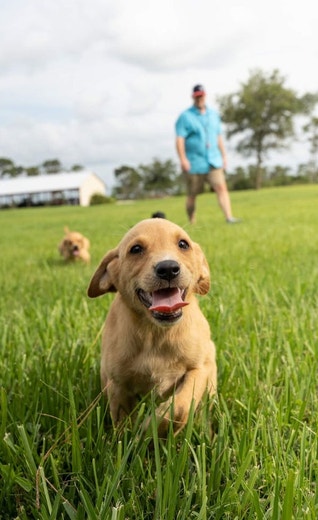
Dog Grooming Tips
GROOMING BASICS FOR A HEALTHY, HAPPY DOG
There are several dog-grooming basics that every dog owner should know and follow. Done regularly, a grooming routine will help your dog’s coat shine and the tactile interaction can also help for puppies socialization. It’s also an opportunity to look for pests such as fleas and ticks, as well as lesions or lumps that can signal health problems.
However, before you buy a brush, here are some factors to consider:
- Regardless of his coat, you should get a “slicker brush” with beds of fine, closely spaced wires that are hooked or bent. This all-purpose tool is ideal for removing mats, tangles, and debris.
- Remove knots in longhaired breeds with a pin brush. The widely spaced tines look like straight pins.
- Bristle brushes are used as a final step to smooth and shine your shorthaired dog.
- Metal combs give the finishing touch to extra-long coats.
Begin your grooming session by using the slicker or pin brush to remove dead hair, debris, and tangles (you might need both tools if you have a longhaired breed or if your shorthaired pet spent the afternoon playing in the dirt). For tough snarls, hold the tangle at the root and gently brush it out to avoid painful pulling. Smooth the coat with a bristle brush or comb. Give your dog a break every few minutes to keep it tolerable.
DOG BATHS
After a thorough brushing, you'll want to wash your dog. Dogs don't need to bathe too frequently, unless they get especially dirty or if it's recommended by the vet.
Fill a basin with warm water (check the temperature using your elbow, which is more sensitive than your hand) and place him on a non-skid surface, talking gently and praising him.
Slowly pour water over his feet, working your way up to his collar. Do not immerse his head yet; give him time to get used to the sensation. Use specially formulated dog shampoo ("people" soaps may be irritating), and lather his coat.
Rinse twice to ensure the suds are out. Wash his head last. Dogs love a good toweling off. If he's patient, try using a blow dryer on low heat.
HAIR CUTS
Scissors can actually be very dangerous to use if a dog has matted fur. It is almost impossible to determine where the skin ends and the mat begins, and cutting them is a common cause of accidental lacerations. If your dog has matted fur, a trip to the groomer is strongly recommended.
DOG PAW CARE
Dogs generally don't like having their paws handled, but it is necessary to make sure the fur between their toes and pads does not become matted—or infected. Here's how:
- Remove any matted hair.
- Carefully use scissors to trim fur so that it is level with the foot.
Next, trim his nails. To help him enjoy this more, provide praise and rewards; it is necessary to ensure his good health. Do the following every few weeks:
- Use a clipper made for dogs.
- Trim only the hook of the nail. Never trim into the quick—the live portion of the nail—that can draw blood.
- If your dog has dewclaws - the thumb-like portions on the paws - make sure to trim them as well. If allowed to grow, they could curl up and pinch the skin.
EAR CARE FOR YOUR DOG
During your pet's bath, wash the outside of his ears with water. Talk to your vet to see if you need an ear cleaning solution for the inside of the ears. If so, warm the bottle in your palms and follow your veterinarian's instructions. Usually, your vet will tell you to squirt a dab of the ear cleaner into the ear canal and to gently massage the base of the ear. Remove dirt or wax with a cotton ball and never use a cotton swab.
DENTAL CARE FOR YOUR DOG
The more often you brush your dog’s teeth, the easier it will become. Use a special dog toothbrush or a finger brush to rub canine toothpaste on the outsides of your pet's teeth and gum line.
Grooming your pet regularly can be a great bonding experience. With practice and patience, you both might come to enjoy it.




